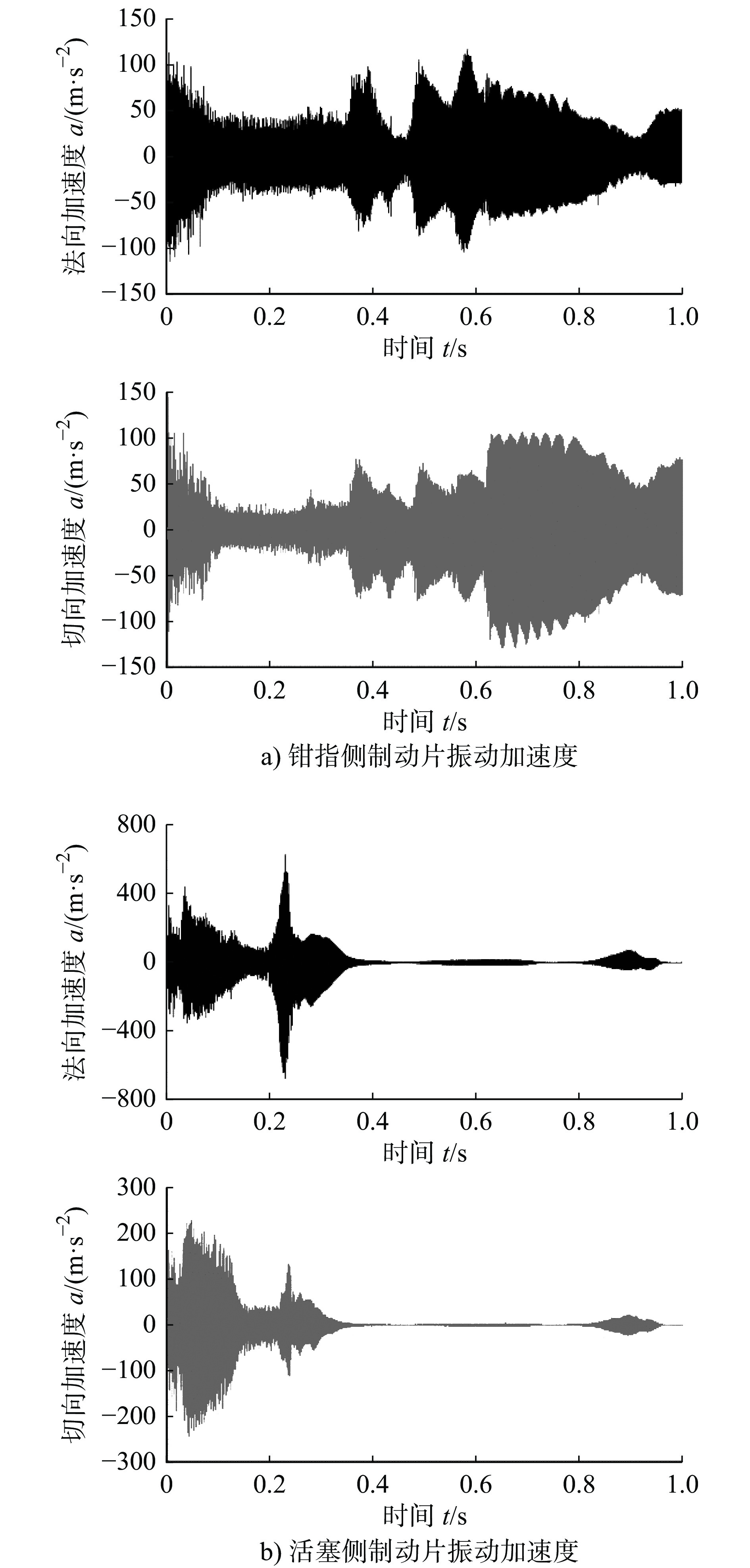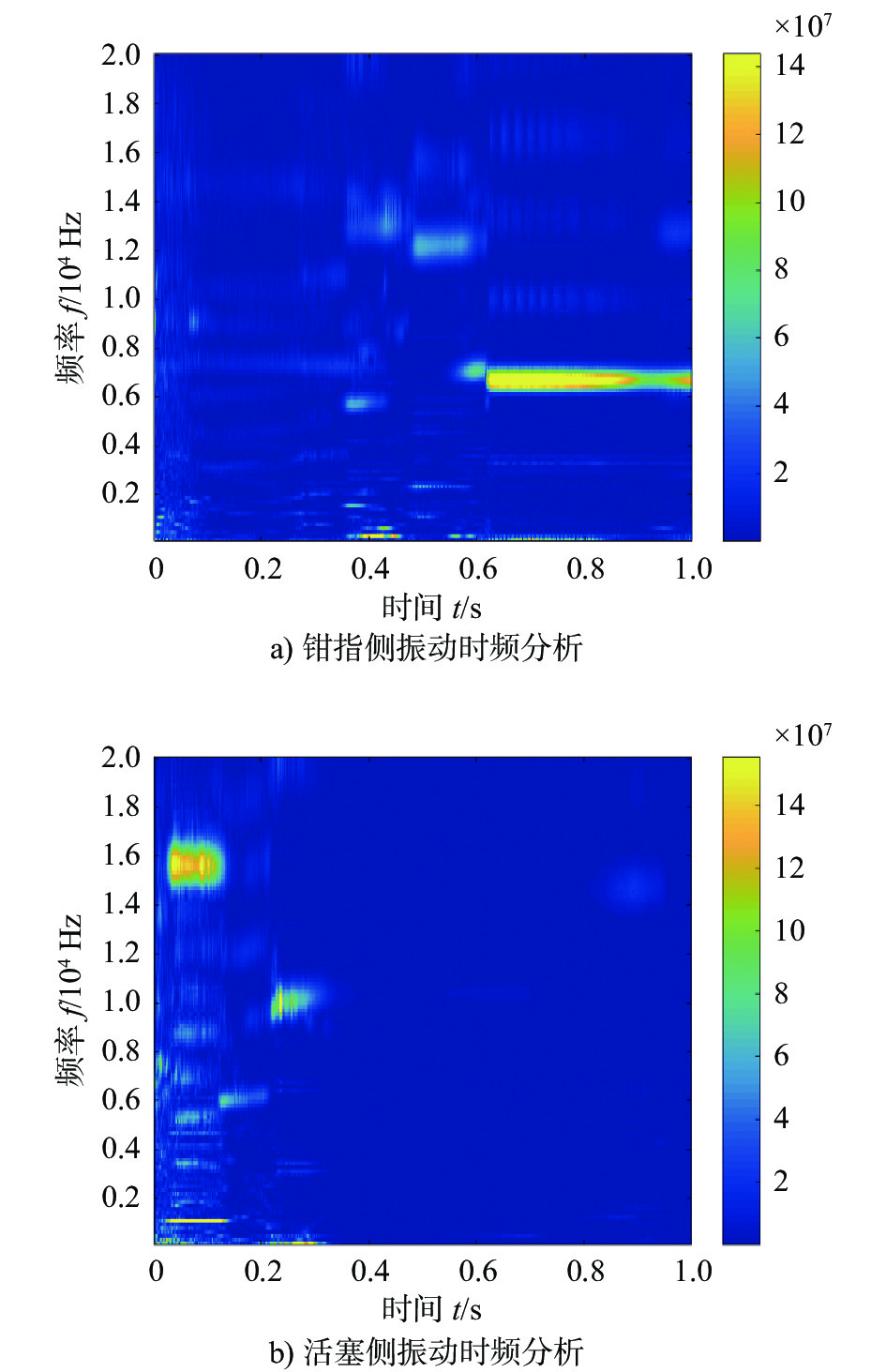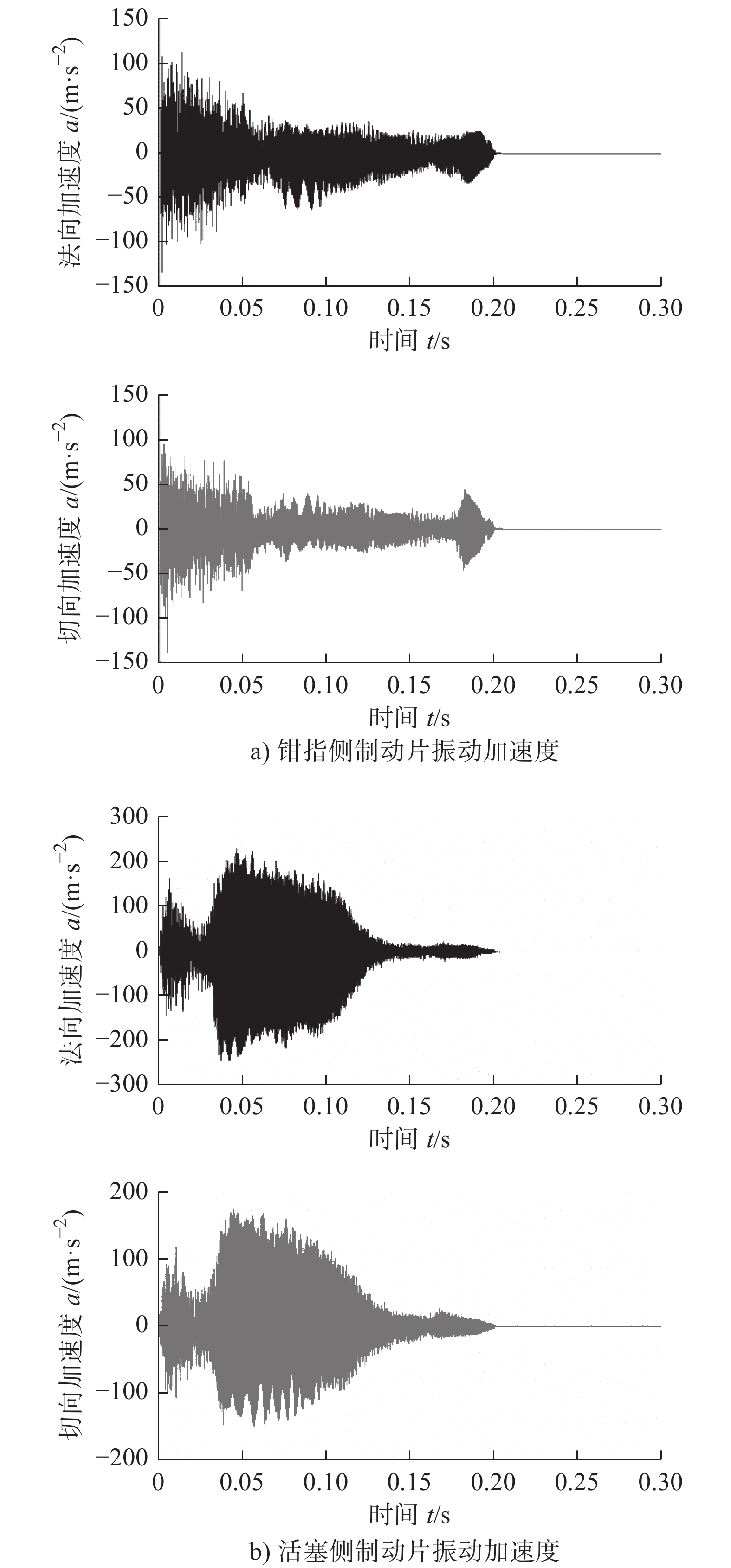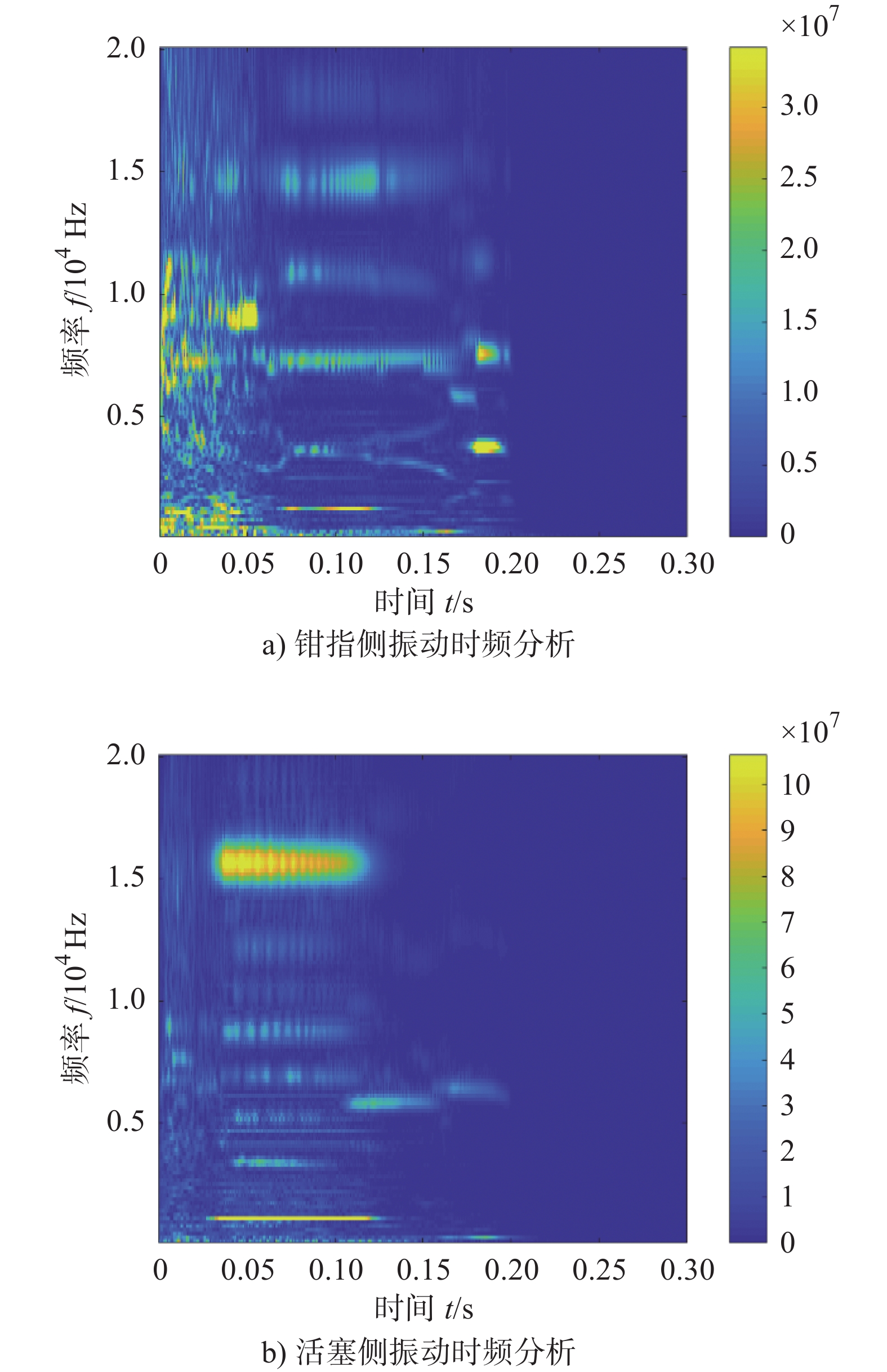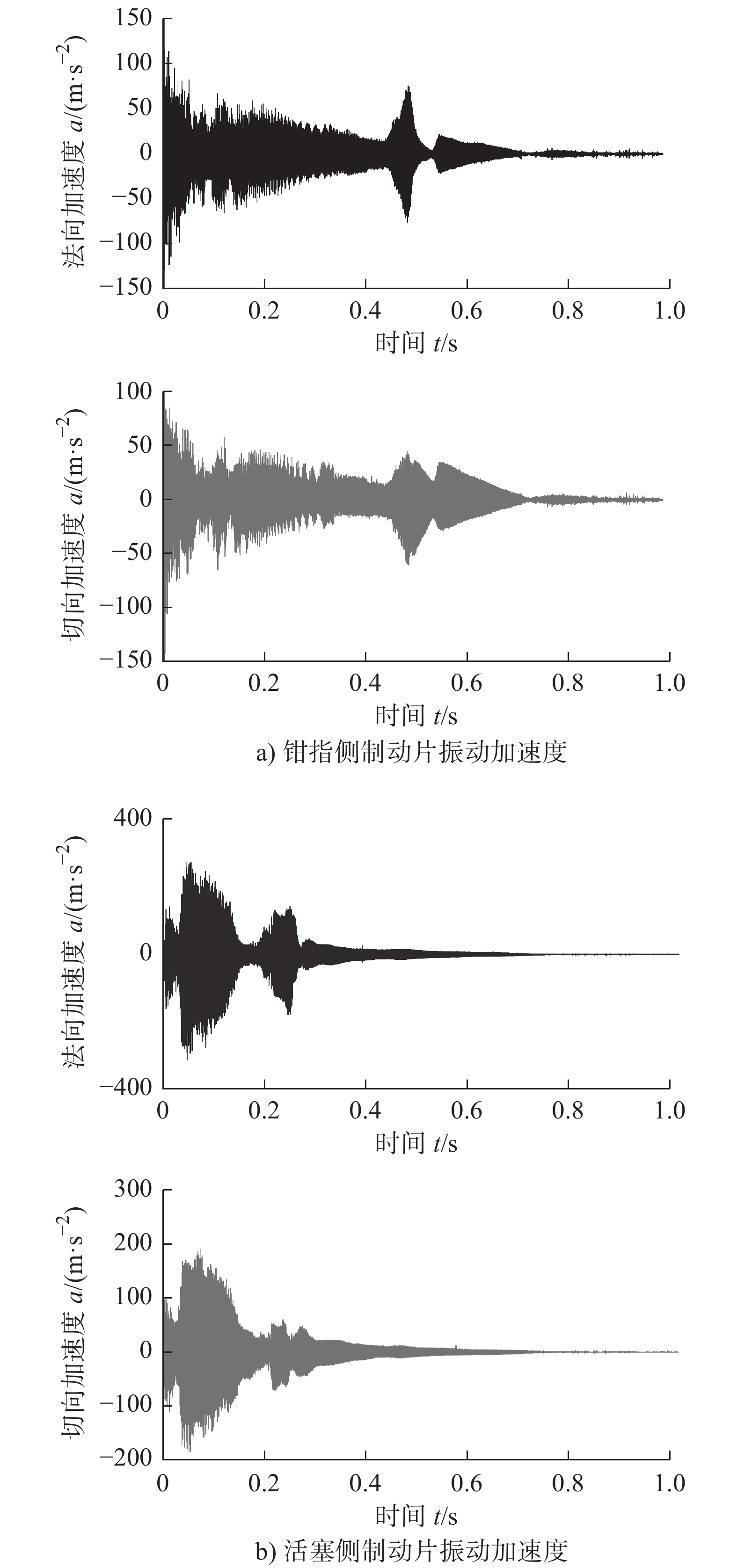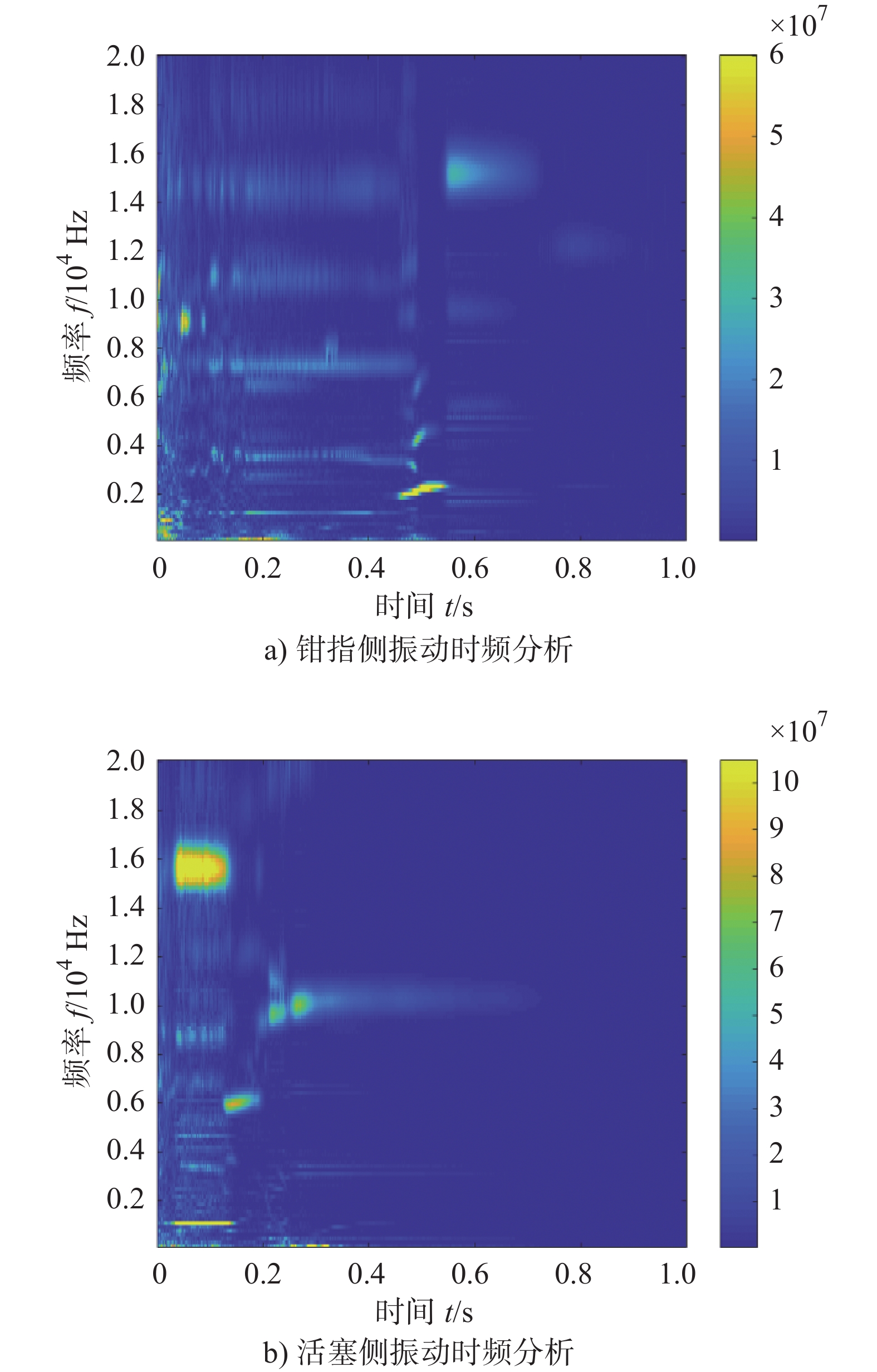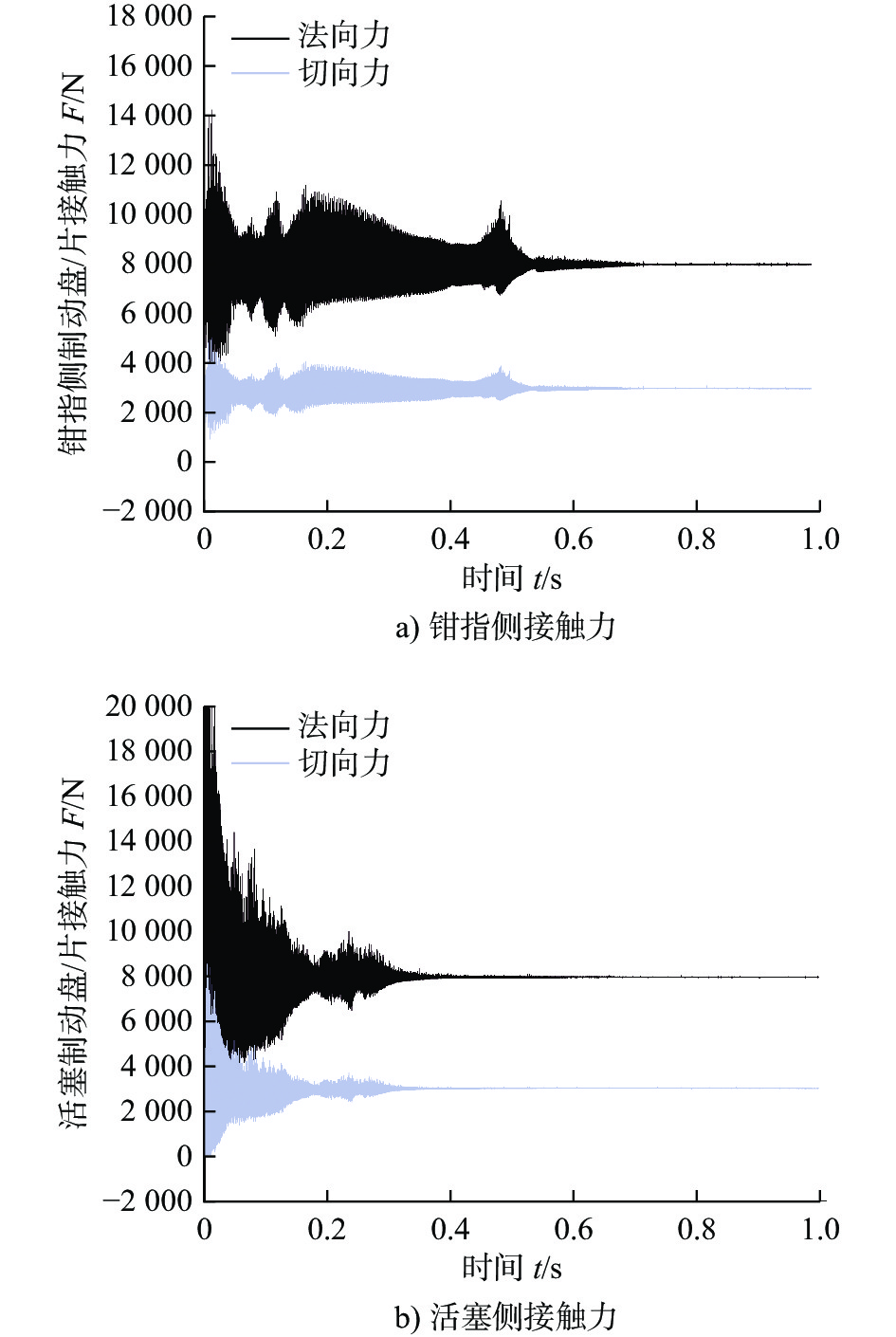Study on Thermal-mechanical Coupling Behavior of Disc Brake System Under Different Braking Modes
-
摘要: 对盘式制动器在拖曳制动、紧急制动和缓慢制动这3种不同制动模式下的热-机耦合行为进行分析。结果表明,在拖曳制动模式下,制动盘两侧摩擦片的变形形式各不相同,因此制动盘两侧摩擦片的温度分布不一致。此外,钳指侧和活塞侧摩擦片的振动信号和接触力信号差异明显,钳指侧对摩擦副的摩擦振动逐渐加剧,并产生新的振动频率;活塞侧对摩擦副的振动趋于稳定,原有的振动频率逐渐消失;在紧急制动模式下,制动盘两侧摩擦片的温度分布特征类似,均是从进摩擦区向出摩擦区扩散,但是由于作用时间较短,温度上升不明显。但两侧摩擦片的振动信号有所区别,尤其是活塞侧摩擦片出现持续自激振动,并且产生新的振动频率。在缓慢制动模式下,虽然制动盘两侧的摩擦片外径均为表面高温区,但在制动后期,活塞侧摩擦片表面高温排布呈现出“点状分布式”特点。钳指侧摩擦片和活塞侧摩擦片的振动信号存在差异,钳指侧摩擦片振动持续时间较长,但其振动强度较活塞侧则更加微弱。界面力学信号分析结果很好地验证了该结论。Abstract: Thermal-mechanical coupling behaviour of disc brake under three different braking modes, namely drag braking, emergency braking and slow braking, is analyzed by using the full thermal-mechanical coupling analysis method. The results show that under the drag braking mode, the temperature distribution of friction pads on both sides of the disc is inconsistent, which is caused by the different deformation forms of friction pads on both sides of brake disc. In addition, the vibration signals and contact force signals of the friction pad between the finger side and the piston side are obviously different. The friction-induced vibration of the pad on the finger side of the disc gradually becomes intensified, and a new vibration frequency is generated, while the vibration of pad on the piston side tends to be stable and the original vibration frequency disappears gradually. In the emergency braking mode, the temperature distribution characteristics of the friction pads on both sides of the brake disc are similar, which are diffused from the inlet friction zone to the outlet friction zone, but the temperature rise is not obvious due to the short time period of action. However, the vibration signals of the friction pads on both sides are totally different, especially that the pad on piston side generates visible and continuous self-excited vibration, and the new vibration frequency is generated. In the slow braking mode, although the outer diameters of the friction pads on both sides are the surface high temperature zone, the high temperature distribution on the surface of the piston pad presents the characteristics of ‘point-like distribution’ in the late braking period. The vibration signals of the friction pad on the finger side are different from those on the piston side. The vibration duration of the friction pad on the finger side is longer, while its vibration intensity is weaker than that on the piston side. The results of interface mechanical signal analysis confirm the conclusion. The results of this study confirm that the thermal-mechanical coupling behaviours of brakes are different under different braking modes.
-
Key words:
- thermal-mechanical coupling /
- brake /
- friction-induced vibration /
- contact temperature
-
表 1 模型的网格数量和特征
Table 1. Number of grids number and characteristics of the model
部件名称 网格数量 网格特征 最小网格尺寸/mm 通风制动盘 36 323 C3D8 + C3D4 3.317 钳指侧摩擦片 17 079 C3D8 0.879 活塞侧摩擦片 17 079 C3D8 0.879 活塞缸 12 421 C3D8 4.260 制动背板 6 885 C3D8 1.002 制动夹钳 112 033 C3D4 2.595 表 2 模型各部件材料参数
Table 2. Material parameters of each component of the model
参数 制动盘 摩擦衬片 制动背板 密度/(kg·m−3) 7 900 2 500 7 200 E/GPa 205 3.50 190 泊松比 0.30 0.28 0.30 比热/107 45 120 42 热传导系数 48 1 48 热膨胀系数 1.1×10−5 1.1×10−5(20 ℃) 1.1×10−5 3.1×10−5(300 ℃) -
[1] 钟志华, 乔英俊, 王建强, 等. 新时代汽车强国战略研究综述(一)[J]. 中国工程科学, 2018, 20(1): 1-10.ZHONG Z H, QIAO Y J, WANG J Q, et al. Summary of strategy research on automobile power in new era (I)[J]. Strategic Study of CAE, 2018, 20(1): 1-10. (in Chinese) [2] 孟德建, 张立军, 阮丞, 等. 摩擦引起的制动器热点问题综述[J]. 同济大学学报(自然科学版), 2014, 42(8): 1203-1210.MENG D J, ZHANG L J, RUAN C, et al. Literature survey of friction-induced hot spots in brakes[J]. Journal of Tongji University (Natural Science), 2014, 42(8): 1203-1210. (in Chinese) [3] 孟德建, 张彬, 徐杰, 等. 制动钳及其约束对制动器热机耦合特性的影响[J]. 同济大学学报(自然科学版), 2019, 47(5): 704-713.MENG D J, ZHANG B, XU J, et al. Effect of brake caliper and its restraint on thermo-mechanical coupling characteristics of disc brake[J]. Journal of Tongji University (Natural Science), 2019, 47(5): 704-713. (in Chinese) [4] 张立军, 陈远, 刁坤, 等. 盘式制动器接触压力与热机耦合特性仿真分析[J]. 同济大学学报(自然科学版), 2013, 41(10): 1554-1561.ZHANG L J, CHEN Y, DIAO K, et al. Computational investigation into disc-pads pressure distribution and thermomechanical coupling characteristics of brake pads in disc brake[J]. Journal of Tongji University (Natural Science), 2013, 41(10): 1554-1561. (in Chinese) [5] BELHOCINE A, ABDULLAH O I. A thermomechanical model for the analysis of disc brake using the finite element method in frictional contact[J]. Journal of Thermal Stresses, 2020, 43(3): 305-320. doi: 10.1080/01495739.2019.1683482 [6] BENHASSINE N, HAIAHEM A, BOU-SAID B. A comparative study of the transient thermomechanical behavior of friction of the ceramic brake discs: temperature field effect[J]. Journal of Mechanical Science and Technology, 2019, 33(1): 233-240. doi: 10.1007/s12206-018-1223-4 [7] YEVTUSHENKO A A, KUCIEJ M. One-dimensional thermal problem of friction during braking: the history of development and actual state[J]. International Journal of Heat and Mass Transfer, 2012, 55(15-16): 4148-4153. doi: 10.1016/j.ijheatmasstransfer.2012.03.056 [8] 张森, 肖林京, 刘强, 等. 汽车通风盘式制动器的摩擦学性能测试和流固热耦合仿真[J]. 汽车工程, 2017, 39(6): 675-682.ZHANG S, XIAO L J, LIU Q, et al. Tribology performance testing and fluid-solid-heat coupling simulation of automotive ventilated disc brake[J]. Automotive Engineering, 2017, 39(6): 675-682. (in Chinese) [9] DJAFRI M, BOUCHETARA M, BUSCH C, et al. Influence of thermal fatigue on the wear behavior of brake discs sliding against organic and semimetallic friction materials[J]. Tribology Transactions, 2018, 61(5): 861-868. doi: 10.1080/10402004.2018.1437491 [10] ZHANG J, XIA C G. Research of the transient temperature field and friction properties on disc brakes[J]. Advanced Materials Research, 2013, 756-759: 4331-4335. doi: 10.4028/www.scientific.net/AMR.756-759.4331 [11] 袁琼, 李仕生. 拖曳与启停制动模式下盘式制动器热-机耦合特性研究[J]. 机械强度, 2020, 42(5): 1191-1197.YUAN Q, LI S S. Study on the thermal-mechanical coupling characteristics of disc brake under drag and start-stop breaking modes[J]. Journal of Mechanical Strength, 2020, 42(5): 1191-1197. (in Chinese) [12] 袁琼, 唐鹏, 李仕生. 制动盘非光滑仿生表面对制动摩擦尖叫行为影响的研究[J]. 现代制造工程, 2020(9): 62-69.YUAN Q, TANG P, LI S S. Study on the influence of non-smooth bionic brake disc on the squeal instability of disc brake system[J]. Modern Manufacturing Engineering, 2020(9): 62-69. (in Chinese) [13] 刘莹, 毕勇强, 宋涛, 等. 矿车盘式制动器热-结构耦合分析[J]. 润滑与密封, 2015, 40(5): 11-15.LIU Y, BI Y Q, SONG T, et al. Thermal-structure coupling analysis on disc brake of mineral car[J]. Lubrication Engineering, 2015, 40(5): 11-15. (in Chinese) [14] 张立军, 刁坤. 面向热机耦合特性分析的制动器摩擦特性模型[J]. 同济大学学报(自然科学版), 2011, 39(11): 1680-1686.ZHANG L J, DIAO K. Friction modeling for thermo-mechanical coupling characterization of disc brake[J]. Journal of Tongji University (Natural Science), 2011, 39(11): 1680-1686. (in Chinese) [15] OUYANG H J, ABU-BAKAR A R, LI L J. A combined analysis of heat conduction, contact pressure and transient vibration of a disk brake[J]. International Journal of Vehicle Design, 2009, 51(1-2): 190-206. [16] ABU BAKAR A R, OUYANG H J, KHAIA L C, et al. Thermal analysis of a disc brake model considering a real brake pad surface and wear[J]. International Journal of Vehicle Structures and Systems, 2010, 2(1): 20-27. [17] 袁琼, 唐鹏, 李仕生. 降低制动摩擦振动的制动器结构拓扑优化设计[J]. 机械科学与技术, 2021, 40(9): 1391-1396.YUAN Q, TANG P, LI S S. Topology optimization design of brake structure to reduce friction-induced vibration and noise[J]. Mechanical Science and Technology for Aerospace Engineering, 2021, 40(9): 1391-1396. (in Chinese) -








 下载:
下载:


